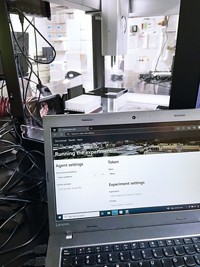Advertisement
Grab your lab coat. Let's get started
Welcome!
Welcome!
Create an account below to get 6 C&EN articles per month, receive newsletters and more - all free.
It seems this is your first time logging in online. Please enter the following information to continue.
As an ACS member you automatically get access to this site. All we need is few more details to create your reading experience.
Not you? Sign in with a different account.
Not you? Sign in with a different account.
ERROR 1
ERROR 1
ERROR 2
ERROR 2
ERROR 2
ERROR 2
ERROR 2
Password and Confirm password must match.
If you have an ACS member number, please enter it here so we can link this account to your membership. (optional)
ERROR 2
ACS values your privacy. By submitting your information, you are gaining access to C&EN and subscribing to our weekly newsletter. We use the information you provide to make your reading experience better, and we will never sell your data to third party members.
Computational Chemistry
AI chemist performs complex experiments based on plain text prompts
On its first try, the technology could successfully replicate work that won a Nobel prize
by Prachi Patel
December 26, 2023

Given simple text prompts, an artificial intelligence-driven system can plan and execute difficult chemical reactions (Nature 2023, DOI: 10.1038/s41586-023-06792-0). The system could ease communication between humans and AI systems to speed up scientific research.
Dubbed Coscientist, the system uses the language model behind the chatbot ChatGPT. With a prompt such as “perform multiple Suzuki reactions”, the AI browses the internet to learn about the reactions, scours relevant literature and hardware documentation for information, and in minutes, outlines the procedures necessary to perform these reactions. It then writes a code, which a robot uses to run the experiment.
“We are converting bits to atoms,” says Gabe Gomes, a chemist and chemical engineer at Carnegie Mellon University, in a press briefing. “Taking a natural language prompt, the bits, and converting it into an actual chemical reaction.”
Coscientist could successfully perform the complex Nobel Prize-winning palladium-catalyzed cross coupling reaction named after Akira Suzuki with a 50% yield the very first time. It could also accurately plan procedures to synthesize common pharmaceutical compounds such as aspirin and ibuprofen. Gomes says he and his team are fully aware of the potential illicit use of Coscientist and are collaborating with other researchers and policymakers to prevent such misuse.
Tiago Rodrigues, a medicinal chemist at the University of Lisbon, says that Coscientist fills the important gap of communication necessary to meet the long-standing goal of self-driving labs. AI chemists such as Coscientist and ChemCrow, which was recently developed by another research team, could enable the full automation of the design-make-test cycle, he says. “This can have tremendous impact in terms of productivity since researchers can dedicate their time to other tasks.”





Join the conversation
Contact the reporter
Submit a Letter to the Editor for publication
Engage with us on Twitter